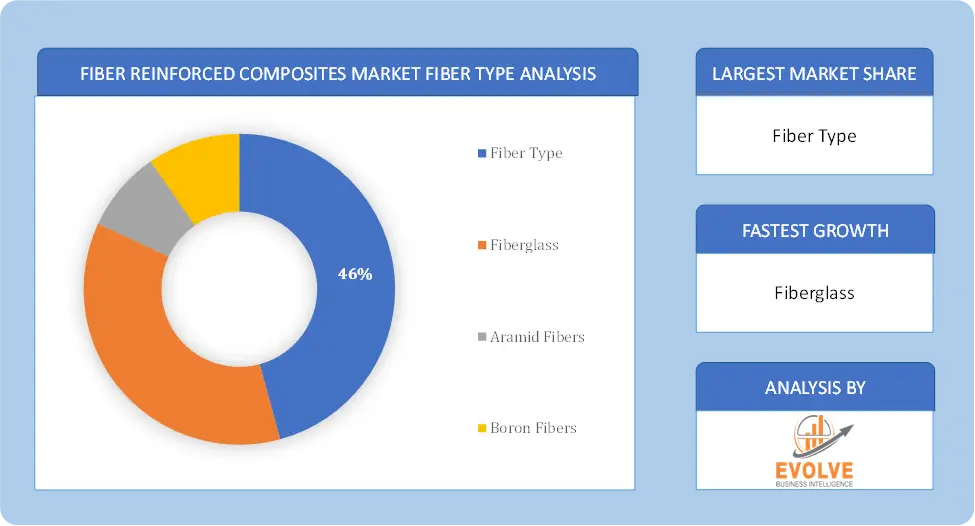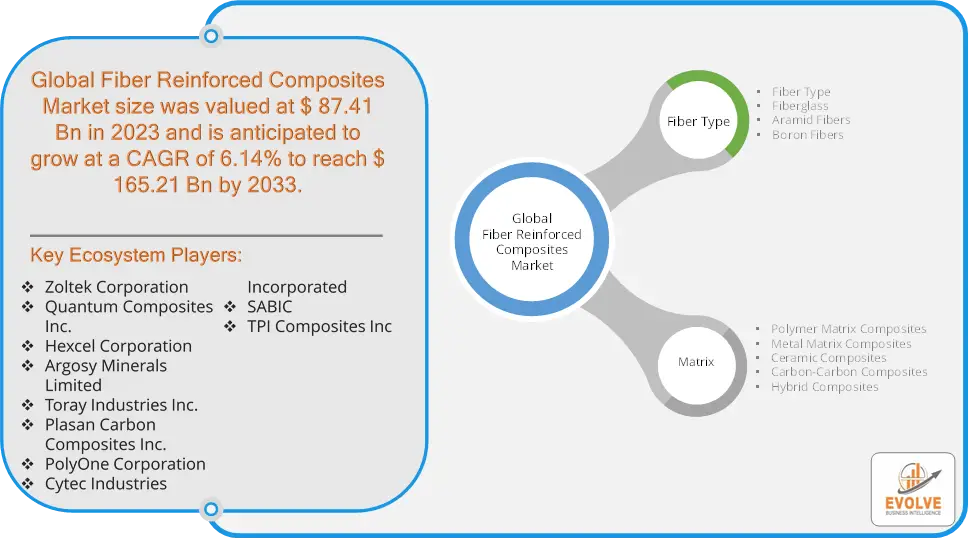Fiber Reinforced Composites Market Analysis and Global Forecast 2023-2033
$ 1,390.00 – $ 5,520.00Price range: $ 1,390.00 through $ 5,520.00
Fiber Reinforced Composites Market Research Report: Information By Fiber Type (Fiber Type, Fiberglass, Aramid Fibers, Boron Fibers), By Matrix (Polymer Matrix Composites, Metal Matrix Composites, Ceramic Composites, Carbon-Carbon Composites, Hybrid Composites), and by Region — Forecast till 2033
Page: 174
Fiber Reinforced Composites Market Overview
The Fiber Reinforced Composites Market Size is expected to reach USD 165.21 Billion by 2033. The Fiber Reinforced Composites Market industry size accounted for USD 87.41 Billion in 2023 and is expected to expand at a compound annual growth rate (CAGR) of 6.14% from 2023 to 2033. The Fiber Reinforced Composites (FRC) Market encompasses the production, distribution, and application of materials made from fibers (such as glass, carbon, or aramid) embedded in a matrix (like polymer, metal, or ceramic). These composites are valued for their high strength-to-weight ratio, durability, and resistance to environmental degradation, making them ideal for use in various industries, including aerospace, automotive, construction, marine, and sports equipment.
The FRC market is poised for significant growth due to ongoing technological advancements and increasing demand from various high-performance applications. The fiber reinforced composites market is thriving due to its potential to revolutionize various industries by offering materials with superior properties.
Global Fiber Reinforced Composites Market Synopsis
The COVID-19 pandemic had a significant impact on the Fiber Reinforced Composites (FRC) Market. Lockdowns and restrictions led to interruptions in the supply of raw materials such as fibers and resins, causing delays and increased costs. Transport restrictions and reduced availability of shipping and freight services disrupted the delivery of components and finished products. Construction projects faced delays and cancellations, reducing the demand for fiber-reinforced composites in infrastructure projects. Companies began to focus more on local supply chains to reduce dependency on international suppliers and mitigate future disruptions. The pandemic accelerated the focus on innovation, with increased interest in sustainable and recyclable composites to address environmental concerns and future market demands. The pandemic highlighted the need for more resilient supply chains and flexible manufacturing processes, prompting companies to invest in digitalization and automation. There is a growing trend towards diversifying applications of fiber-reinforced composites beyond traditional sectors to include renewable energy (e.g., wind turbine blades) and medical equipment.
Fiber Reinforced Composites Market Dynamics
The major factors that have impacted the growth of Fiber Reinforced Composites Market are as follows:
Drivers:
Ø Automotive Industry Push for Lightweight Materials
With stringent regulations on fuel efficiency and emissions, the automotive industry is increasingly adopting FRCs to reduce vehicle weight and improve fuel economy, contributing to the market growth. Technological advancements in manufacturing processes, such as automated layup, resin transfer molding (RTM), and 3D printing, have reduced production costs and increased the efficiency of producing fiber reinforced composites. The renewable energy sector, particularly wind energy, is driving the demand for FRCs for use in wind turbine blades due to their high strength, lightweight, and fatigue resistance.
Restraint:
- Perception of High Initial Costs and Technical Expertise
The manufacturing of fiber reinforced composites, especially those made with advanced fibers like carbon fiber, can be significantly more expensive than traditional materials. This includes the costs of raw materials, specialized equipment, and skilled labor. Setting up facilities for producing FRCs requires substantial initial investment in technology and infrastructure, which can be a barrier for small and medium-sized enterprises. The production of FRCs involves complex processes such as layup, curing, and molding, which require specialized knowledge and expertise. This complexity can deter companies from adopting these materials.
Opportunity:
⮚ Advancements in Material Science
Ongoing research and development in material science are leading to the creation of new fibers (e.g., basalt fibers, bio-based fibers) and resins that offer improved performance, lower costs, and enhanced sustainability. Incorporating nanomaterials into fiber reinforced composites can enhance their properties, such as increasing strength, thermal stability, and electrical conductivity, opening up new application possibilities. Integrating sensors and smart technologies into FRCs can enable the development of smart composites with capabilities such as structural health monitoring, which can be used in critical applications like bridges, aircraft, and industrial machinery. Advancements in 3D printing and additive manufacturing techniques for FRCs are enabling the production of complex and customized parts with reduced waste and lower costs.
Fiber Reinforced Composites Market Segment Overview
By Fiber Type
 Based on Fiber Type, the market is segmented based on Fiber Type, Fiberglass, Aramid Fibers and Boron Fibers. The Fiberglass segment dominant the market. Glass fiber, often known as fiberglass, is mainly composed of silica filaments with diameters between several micrometers. Glass fibers have high mechanical strength and a high cost-to-performance ratio. E-glass, C-glass, and S-glass are the most common forms of glass fibers. Glass fibers reinforce polymers in numerous industries, including aerospace, car, marine, athletic & leisure goods, construction & civil engineering, and others. It is also used to produce structural composites in the automotive industry, the primary market driver for fiberglass composites.
Based on Fiber Type, the market is segmented based on Fiber Type, Fiberglass, Aramid Fibers and Boron Fibers. The Fiberglass segment dominant the market. Glass fiber, often known as fiberglass, is mainly composed of silica filaments with diameters between several micrometers. Glass fibers have high mechanical strength and a high cost-to-performance ratio. E-glass, C-glass, and S-glass are the most common forms of glass fibers. Glass fibers reinforce polymers in numerous industries, including aerospace, car, marine, athletic & leisure goods, construction & civil engineering, and others. It is also used to produce structural composites in the automotive industry, the primary market driver for fiberglass composites.
By Matrix
Based on Matrix, the market segment has been divided into the Polymer Matrix Composites, Metal Matrix Composites, Ceramic Composites, Carbon-Carbon Composites and Hybrid Composites. The Metal Matrix Composites segment dominant the market. MMCs are used in armor plating for vehicles and personal protection due to their high strength and resistance to ballistic impact. MMCs are used for manufacturing cutting tools and wear-resistant parts due to their hardness and wear resistance.
Global Fiber Reinforced Composites Market Regional Analysis
Based on region, the global Fiber Reinforced Composites Market has been divided into North America, Europe, Asia-Pacific, the Middle East & Africa, and Latin America. North America is projected to dominate the use of the Fiber Reinforced Composites Market followed by the Asia-Pacific and Europe regions.
Global Fiber Reinforced Composites North America Market
North America holds a dominant position in the Fiber Reinforced Composites Market. the strong presence of the aerospace, defense, and automotive industries drives demand for FRCs in this region. Government investments in infrastructure and renewable energy also contribute to market growth. Adoption of advanced manufacturing technologies, increasing use of sustainable and recyclable composites, and significant investment in R&D.
Global Fiber Reinforced Composites Asia-Pacific Market
The Asia-Pacific region has indeed emerged as the fastest-growing market for the Fiber Reinforced Composites Market industry. Rapid industrialization, urbanization, and growing infrastructure projects drive the demand for FRCs. The expanding automotive and electronics industries also contribute to market growth and increasing investment in renewable energy, rising adoption of FRCs in consumer electronics, and significant growth in the automotive sector focusing on lightweighting for fuel efficiency.
Competitive Landscape
The global Fiber Reinforced Composites Market is highly competitive, with numerous players offering a wide range of software solutions. The competitive landscape is characterized by the presence of established companies, as well as emerging startups and niche players. To increase their market position and attract a wide consumer base, the businesses are employing various strategies, such as product launches, and strategic alliances.
Prominent Players:
- Zoltek Corporation
- Quantum Composites Inc.
- Hexcel Corporation
- Argosy Minerals Limited
- Toray Industries Inc.
- Plasan Carbon Composites Inc.
- PolyOne Corporation
- Cytec Industries Incorporated
- SABIC
- TPI Composites Inc
Scope of the Report
Global Fiber Reinforced Composites Market, by Fiber Type
- Fiber Type
- Fiberglass
- Aramid Fibers
- Boron Fibers
Global Fiber Reinforced Composites Market, by Matrix
- Polymer Matrix Composites
- Metal Matrix Composites
- Ceramic Composites
- Carbon-Carbon Composites
- Hybrid Composites
Global Fiber Reinforced Composites Market, by Region
- North America
- US
- Canada
- Mexico
- Europe
- UK
- Germany
- France
- Italy
- Spain
- Benelux
- Nordic
- Rest of Europe
- Asia Pacific
- China
- Japan
- South Korea
- Indonesia
- Austalia
- Malaysia
- India
- Rest of Asia Pacific
- South America
- Brazil
- Argentina
- Rest of South America
- Middle East & Africa
- Saudi Arabia
- UAE
- Egypt
- South Africa
- Rest of Middle East & Africa
| Parameters | Indicators |
|---|---|
| Market Size | 2033: $165.21 Billion |
| CAGR | 6.14% CAGR (2023-2033) |
| Base year | 2022 |
| Forecast Period | 2023-2033 |
| Historical Data | 2021 |
| Report Coverage | Revenue Forecast, Competitive Landscape, Growth Factors, and Trends |
| Key Segmentations | Fiber Type, Matrix |
| Geographies Covered | North America, Europe, Asia-Pacific, Latin America, Middle East, Africa |
| Key Vendors | Zoltek Corporation, Quantum Composites Inc., Hexcel Corporation, Argosy Minerals Limited, Toray Industries Inc., Plasan Carbon Composites Inc., PolyOne Corporation, Cytec Industries Incorporated, SABIC and TPI Composites Inc. |
| Key Market Opportunities | • Advancements in Material Science • Technological Integration |
| Key Market Drivers | • Automotive Industry Push for Lightweight Materials • Advancements in Manufacturing Technologies |
REPORT CONTENT BRIEF:
- High-level analysis of the current and future Fiber Reinforced Composites Market trends and opportunities
- Detailed analysis of current market drivers, restraining factors, and opportunities in the future
- Fiber Reinforced Composites Market historical market size for the year 2021, and forecast from 2023 to 2033
- Fiber Reinforced Composites Market share analysis at each product level
- Competitor analysis with detailed insight into its product segment, Government & Defense strength, and strategies adopted.
- Identifies key strategies adopted including product launches and developments, mergers and acquisitions, joint ventures, collaborations, and partnerships as well as funding taken and investment done, among others.
- To identify and understand the various factors involved in the global Fiber Reinforced Composites Market affected by the pandemic
- To provide a detailed insight into the major companies operating in the market. The profiling will include the Government & Defense health of the company’s past 2-3 years with segmental and regional revenue breakup, product offering, recent developments, SWOT analysis, and key strategies.
Press Release

Global Pharmaceutical Manufacturing Market to Reach $1.38 Trillion by 2035 with 7.35% CAGR, New Research Shows

The Global Mammography Market Is Estimated To Record a CAGR of Around 10.29% During The Forecast Period

Glue Stick Market to Reach USD 2.35 Billion by 2034

Podiatry Service Market to Reach USD 11.88 Billion by 2034

Microfluidics Technology Market to Reach USD 32.58 Billion by 2034

Ferric Chloride Market to Reach USD 10.65 Billion by 2034

Family Practice EMR Software Market to Reach USD 21.52 Billion by 2034

Electric Hairbrush Market to Reach USD 15.95 Billion by 2034

Daily Bamboo Products Market to Reach USD 143.52 Billion by 2034

Cross-border E-commerce Logistics Market to Reach USD 112.65 Billion by 2034
Frequently Asked Questions (FAQ)
What is the study period of this market?
The study period of the global Fiber Reinforced Composites Market is 2021- 2033
What is the growth rate of the global Fiber Reinforced Composites Market?
The global Fiber Reinforced Composites Market is growing at a CAGR of 6.14% over the next 10 years
Which region has the highest growth rate in the market of Fiber Reinforced Composites Market?
Asia Pacific is expected to register the highest CAGR during 2023-2033
Which region has the largest share of the global Fiber Reinforced Composites Market?
North America holds the largest share in 2022
Who are the key players in the global Fiber Reinforced Composites Market?
Zoltek Corporation, Quantum Composites Inc., Hexcel Corporation, Argosy Minerals Limited, Toray Industries Inc., Plasan Carbon Composites Inc., PolyOne Corporation, Cytec Industries Incorporated, SABIC and TPI Composites Inc are the major companies operating in the market.
Do you offer Post Sale Support?
Yes, we offer 16 hours of analyst support to solve the queries
Do you sell particular sections of a report?
Yes, we provide regional as well as country-level reports. Other than this we also provide a sectional report. Please get in contact with our sales representatives
Table of Content
Chapter 1. Executive Summary Chapter 2. Scope Of The Study 2.1. Market Definition 2.2. Scope Of The Study 2.2.1. Objectives of Report Chapter 3. Evolve BI Methodology Chapter 4. Market Insights and Trends 4.1. Supply/ Value Chain Analysis 4.2. Porter’s Five Forces Analysis 4.2.1. Threat Of New Entrants 4.2.2. Bargaining Power Of Buyers 4.2.3. Bargaining Power Of Suppliers 4.2.4. Threat Of Substitutes 4.2.5. Industry Rivalry 4.3. Impact of COVID-19 on Fiber Reinforced Composites Market 4.3.1. Impact on Market Size 4.3.2. End User Trend, Preferences and Budget Impact 4.3.3. Regulatory Framework/Government Policies 4.3.4. Key Players Strategy to Tackle Negative Impact 4.3.5. Opportunity Window Chapter 5. Market Dynamics 5.1. Introduction 5.2. DRO Analysis 5.2.1. Drivers 5.2.2. Restraints 5.2.3. Opportunities Chapter 6. Global Fiber Reinforced Composites Market, By Fiber Type 6.1. Introduction 6.2. Fiber Type 6.3. Fiberglass 6.3. Aramid Fibers 6.4. Boron Fibers Chapter 7. Global Fiber Reinforced Composites Market, By Matrix 7.1. Introduction 7.2. Polymer Matrix Composites 7.3. Metal Matrix Composites 7.4. Ceramic Composites 7.5. Carbon-Carbon Composites 7.6. Hybrid Composites Chapter 8. Global Fiber Reinforced Composites Market, By Region 8.1. Introduction 8.2. North America 8.2.1. Introduction 8.2.2. Driving Factors, Opportunity Analyzed and Key Trends 8.2.3. Market Size and Forecast, By Country, 2020 - 2028 8.2.4. Market Size and Forecast, By Fiber Type, 2020 - 2028 8.2.5. Market Size and Forecast, By Matrix, 2020 – 2026 8.2.6. US 8.2.6.1. Introduction 8.2.6.2. Driving Factors, Opportunity Analyzed and Key Trends 8.2.6.3. Market Size and Forecast, By Fiber Type, 2020 - 2028 8.2.6.4. Market Size and Forecast, By Matrix, 2020 - 2028 8.2.7. Canada 8.2.7.1. Introduction 8.2.7.2. Driving Factors, Opportunity Analyzed and Key Trends 8.2.7.3. Market Size and Forecast, By Fiber Type, 2020 - 2028 8.2.7.4. Market Size and Forecast, By Matrix, 2020 - 2028 8.3. Europe 8.3.1. Introduction 8.3.2. Driving Factors, Opportunity Analyzed and Key Trends 8.3.3. Market Size and Forecast, By Country, 2020 - 2028 8.3.4. Market Size and Forecast, By Fiber Type, 2020 - 2028 8.3.5. Market Size and Forecast, By Matrix, 2020 – 2026 8.3.6. Germany 8.3.6.1. Introduction 8.3.6.2. Driving Factors, Opportunity Analyzed and Key Trends 8.3.6.3. Market Size and Forecast, By Fiber Type, 2020 - 2028 8.3.6.4. Market Size and Forecast, By Matrix, 2020 - 2028 8.3.7. France 8.3.7.1. Introduction 8.3.7.2. Driving Factors, Opportunity Analyzed and Key Trends 8.3.7.3. Market Size and Forecast, By Fiber Type, 2020 - 2028 8.3.7.4. Market Size and Forecast, By Matrix, 2020 - 2028 8.3.8. UK 8.3.8.1. Introduction 8.3.8.2. Driving Factors, Opportunity Analyzed and Key Trends 8.3.8.3. Market Size and Forecast, By Fiber Type, 2020 - 2028 8.3.8.4. Market Size and Forecast, By Matrix, 2020 - 2028 8.3.9. Italy 8.3.9.1. Introduction 8.3.9.2. Driving Factors, Opportunity Analyzed and Key Trends 8.3.9.3. Market Size and Forecast, By Fiber Type, 2020 - 2028 8.3.9.4. Market Size and Forecast, By Matrix, 2020 - 2028 8.3.10. Rest Of Europe 8.3.10.1. Introduction 8.3.10.2. Driving Factors, Opportunity Analyzed and Key Trends 8.3.10.3. Market Size and Forecast, By Fiber Type, 2020 - 2028 8.3.10.4. Market Size and Forecast, By Matrix, 2020 - 2028 8.4. Asia-Pacific 8.4.1. Introduction 8.4.2. Driving Factors, Opportunity Analyzed and Key Trends 8.4.3. Market Size and Forecast, By Country, 2020 - 2028 8.4.4. Market Size and Forecast, By Fiber Type, 2020 - 2028 8.4.5. Market Size and Forecast, By Matrix, 2020 - 2028 8.4.6. China 8.4.6.1. Introduction 8.4.6.2. Driving Factors, Opportunity Analyzed and Key Trends 8.4.6.3. Market Size and Forecast, By Fiber Type, 2020 - 2028 8.4.6.4. Market Size and Forecast, By Matrix, 2020 - 2028 8.4.7. India 8.4.7.1. Introduction 8.4.7.2. Driving Factors, Opportunity Analyzed and Key Trends 8.4.7.3. Market Size and Forecast, By Fiber Type, 2020 - 2028 8.4.7.4. Market Size and Forecast, By Matrix, 2020 - 2028 8.4.8. Japan 8.4.8.1. Introduction 8.4.8.2. Driving Factors, Opportunity Analyzed and Key Trends 8.4.8.3. Market Size and Forecast, By Fiber Type, 2020 - 2028 8.4.8.4. Market Size and Forecast, By Matrix, 2020 - 2028 8.4.9. South Korea 8.4.9.1. Introduction 8.4.9.2. Driving Factors, Opportunity Analyzed and Key Trends 8.4.9.3. Market Size and Forecast, By Fiber Type, 2020 - 2028 8.4.9.4. Market Size and Forecast, By Matrix, 2020 - 2028 8.4.10. Rest Of Asia-Pacific 8.4.10.1. Introduction 8.4.10.2. Driving Factors, Opportunity Analyzed and Key Trends 8.4.10.3. Market Size and Forecast, By Fiber Type, 2020 - 2028 8.4.10.4. Market Size and Forecast, By Matrix, 2020 - 2028 8.5. Rest Of The World (RoW) 8.5.1. Introduction 8.5.2. Driving Factors, Opportunity Analyzed and Key Trends 8.5.3. Market Size and Forecast, By Fiber Type, 2020 - 2028 8.5.4. Market Size and Forecast, By Matrix, 2020 - 2028 8.5.5. Market Size and Forecast, By Region, 2020 - 2028 8.5.6. South America 8.5.6.1. Introduction 8.5.6.2. Driving Factors, Opportunity Analyzed and Key Trends 8.5.6.3. Market Size and Forecast, By Fiber Type, 2020 - 2028 8.5.6.4. Market Size and Forecast, By Matrix, 2020 - 2028 8.5.7. Middle East and Africa 8.5.7.1. Introduction 8.5.7.2. Driving Factors, Opportunity Analyzed and Key Trends 8.5.7.3. Market Size and Forecast, By Fiber Type, 2020 - 2028 8.5.7.4. Market Size and Forecast, By Matrix, 2020 - 2028 Chapter 9. Competitive Landscape 9.1. Introduction 9.2. Vendor Share Analysis, 2020/Key Players Positioning, 2020 Chapter 10. Company Profiles 10.1. Zoltek Corporation 10.1.1. Business Overview 10.1.2. Financial Analysis 10.1.3. Product Portfolio 10.1.4. Recent Development and Strategies Adopted 10.1.5. SWOT Analysis 10.2. Quantum Composites, Inc. 10.2.1. Business Overview 10.2.2. Financial Analysis 10.2.3. Product Portfolio 10.2.4. Recent Development and Strategies Adopted 10.2.5. SWOT Analysis 10.3. Hexcel Corporation 10.3.1. Business Overview 10.3.2. Financial Analysis 10.3.3. Product Portfolio 10.3.4. Recent Development and Strategies Adopted 10.3.5. SWOT Analysis 10.4. Argosy Minerals Limited 10.4.1. Business Overview 10.4.2. Financial Analysis 10.4.3. Product Portfolio 10.4.4. Recent Development and Strategies Adopted 10.4.5. SWOT Analysis 10.5. Toray Industries, Inc. 10.5.1. Business Overview 10.5.2. Financial Analysis 10.5.3. Product Portfolio 10.5.4. Recent Development and Strategies Adopted 10.5.5. SWOT Analysis 10.6. Plasan Carbon Composites, Inc. 10.6.1. Business Overview 10.6.2. Financial Analysis 10.6.3. Product Portfolio 10.6.4. Recent Development and Strategies Adopted 10.6.5. SWOT Analysis 10.7. PolyOne Corporation 10.7.1. Business Overview 10.7.2. Financial Analysis 10.7.3. Product Portfolio 10.7.4. Recent Development and Strategies Adopted 10.7.5. SWOT Analysis 10.8. Cytec Industries Incorporated 10.8.1. Business Overview 10.8.2. Financial Analysis 10.8.3. Product Portfolio 10.8.4. Recent Development and Strategies Adopted 10.8.5. SWOT Analysis 10.9. SABIC 10.9.1. Business Overview 10.9.2. Financial Analysis 10.9.3. Product Portfolio 10.9.4. Recent Development and Strategies Adopted 10.9.5. SWOT Analysis 10.10. TPI Composites Inc 10.10.1. Business Overview 10.10.2. Financial Analysis 10.10.3. Product Portfolio 10.10.4. Recent Development and Strategies Adopted 10.10.5. SWOT Analysis Chapter 11. Key Takeaways
Connect to Analyst
Research Methodology







